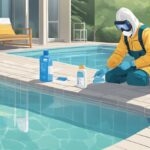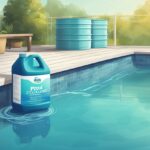Maintaining a sparkling clean pool is essential for both the aesthetic appeal and the health of those who enjoy swimming in it. Algae in your pool can be a frustrating issue, manifesting as unsightly green, yellow, or black spots that can quickly turn your clear water into a murky pond. Fortunately, with appropriate steps, you can eradicate this common nuisance and restore your pool to its former glory.

Effective algae prevention is pivotal in pool maintenance. Regularly checking and balancing your pool water’s pH levels, usually aiming for a range between 7.2 and 7.6, creates an environment less favourable for algae to thrive. Additionally, ensuring proper water circulation and filtration can prevent algae spores from settling and proliferating. Implementing these preventive measures will significantly reduce the likelihood of algae takeovers.
Understanding Pool Algae and Water Chemistry
Addressing the issue of algae in your pool requires an understanding of different algae types and maintaining the correct water chemistry. Key elements include keeping pH and alkalinity balanced and ensuring adequate chlorine levels.
Identify Different Types of Algae
There are three primary types of algae you may encounter in your pool: green, black, and mustard algae. Green algae is the most common, typically floating in the water or clinging to the walls and making your pool look like a green soup. Black algae are more resilient and appear as dark black or blue-green spots, mainly in the crevices or on pool surfaces. Mustard algae, also known as yellow algae, is chlorine-resistant and often mistaken for dirt or sand due to its yellow-brownish colour.
Balancing pH and Alkalinity
Proper pH levels and alkalinity are vital for effective algae treatment and pool maintenance. Your pool’s pH should be maintained between 7.4 and 7.6. This level optimises the chlorine effectiveness and minimises discomfort for swimmers. The total alkalinity, a measure of the water’s ability to neutralise acids, should stay within the range of 100-150 parts per million (ppm). Proper alkalinity acts as a buffer for the pH, keeping it stable.
Importance of Chlorine Levels
Chlorine is the primary disinfectant for pool water, but its effectiveness is influenced by the water chemistry. Maintaining the correct free chlorine levels is crucial to eliminate algae. A range of 2-3 ppm is ideal for regular maintenance, but a higher level is required to kill existing algae. Cyanuric acid helps stabilise free chlorine by protecting it from sunlight degradation, ensuring it remains in the water longer to combat algae. However, it is important not to exceed an ideal range of 30-50 ppm of cyanuric acid, as too much can reduce the efficacy of chlorine.
Regular Pool Maintenance for Algae Prevention
To keep your pool free from algae, prioritising regular maintenance is crucial. Efficient circulation and filtration, along with a systematic cleaning regime, are your first line of defence.
Pool Circulation and Filtration
It’s essential to maintain proper water circulation and utilise a well-functioning filtration system to prevent algae. Adequate circulation helps distribute chlorine evenly, stopping algae before it starts. Ensure your pool filter runs for at least 8-10 hours daily to maintain clarity and cleanliness. Regularly clean your pool filter to avoid clogs that can hinder water flow and filtration efficiency.
Routine Cleaning and Brushing
A consistent pool maintenance routine includes routine cleaning and brushing. Weekly, you should brush the walls, floor, and steps with a pool brush suited to your pool’s surface. This dislodges algae spores, making them vulnerable to chlorine. Vacuuming the pool also removes debris that can contribute to algae growth. Regularly empty skimmer baskets and check the pump strainer basket to keep your filtration system in top condition.
Algae Treatment and Removal Strategies
Effective algae removal consists of three key strategies: shocking the pool with high levels of chlorine, applying specialised algaecides, and physically removing the dead algae through vacuuming. These methods should target not just the visible signs of algae but also any spores left in the water to prevent future algae blooms.
Shocking Your Pool
Shock treatment is your first line of defence against an algae bloom. This involves adding a large dose of chlorine to your pool water, which is known as shocking. For green algae, you’ll need a high concentration, typically 10 times the normal amount. A standard chlorine shock treatment calls for 2 cups (400 grams) of granulated chlorine. This high chlorine level will kill the algae present in your pool.
- Instructions:
- Ensure your pool’s pH is between 7.1 and 7.3 for maximum effectiveness.
- Add the chlorine shock treatment according to the manufacturer’s instructions.
- Run your filter for 24 hours to distribute the chlorine evenly.
Applying Algaecides
After shocking your pool, it’s beneficial to add an algaecide specifically designed to eliminate the remaining algae and prevent it from returning. Algaecides are chemicals that need to be used with caution, following the instructions closely.
- Steps:
- Wait until the chlorine levels drop back to normal after shocking.
- Evenly distribute the algaecide across the pool surface, paying particular attention to problem areas.
- Run your pool filter for several hours to ensure thorough mixing.
Vacuuming Dead Algae
Finally, vacuum your pool manually to remove the dead algae settled at the bottom. This is a crucial step to physically clear the pool and prevent the algae from returning.
- Tips:
- Use a manual pool vacuum to ensure all areas are reached, including under stairs and in corners.
- Vacuum slowly to avoid stirring up the dead algae, making it harder to remove.
Advanced Algae Removal Techniques

When tackling stubborn algae in your swimming pool, you may need to employ advanced techniques to restore water clarity and health, particularly when faced with severe blooms or when rapid action is required.
Dealing With Severe Algae Blooms
Severe algae blooms, especially the obstinate green, black, or yellow varieties, demand a rigorous approach. Begin by thoroughly brushing your pool’s walls, floor, and steps to loosen the algae. For black algae, a tight-bristled pool brush is essential as it has the toughest structure, requiring more force to dislodge from pool surfaces. Yellow algae, also known as mustard algae, is more resistant to chlorine and often settles in shady areas, so targeted brushing and application of algaecide are critical. In the case of green algae, the most common type, ensure to cover all areas as it spreads quickly. After brushing, it’s vital to shock your pool with a high dose of chlorine. This process may need to be repeated over several days, ensuring you backwash or clean your filter to prevent trapped algae from returning to the pool.
Using Flocculants to Clarify Water
For cloudy water resulting from dead algae particles, applying a pool flocculant can be highly effective. Flocculants, or floc, cause suspended particles to bind together and settle at the bottom of the pool, which can then be removed via vacuuming to waste—bypassing the filter and preventing clogging. To use, ensure the pool’s pH is balanced, then add the recommended dose of flocculant and let the pump run, ensuring thorough distribution. After the particles have settled, carefully vacuum the pool, making sure to remove all the waste from the pool bottom. Keep in mind that this process requires a manual vacuum as automatic pool cleaners might not effectively collect the floc.











